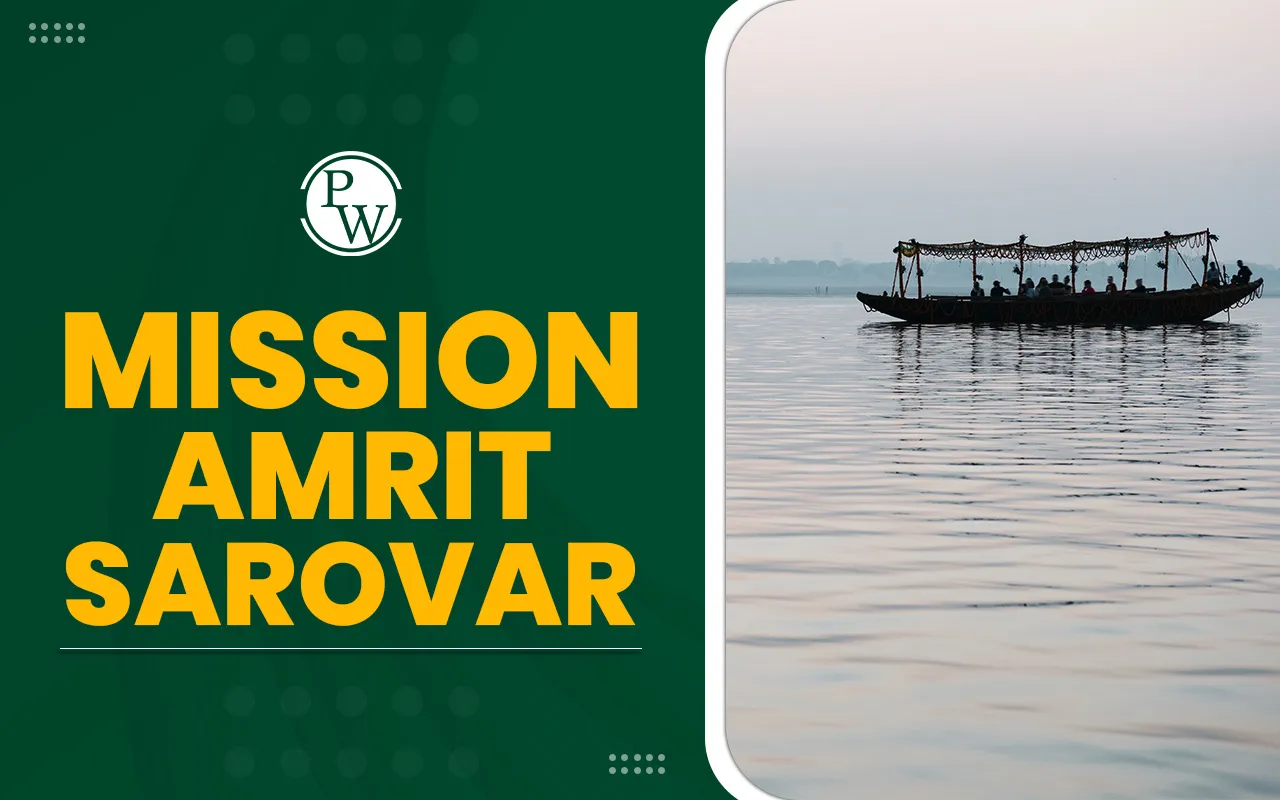
Mission Amrit Sarovar was launched in the backdrop of the Azadi Ka Amrit Mahotsav celebrations, to develop and rejuvenate 75 water bodies in each district of India. The initiative, launched in April 2022 by the Government of India, is focused on promoting water conservation, enhancing rural livelihoods, and reviving traditional water sources to ensure water security. So far over 68,000 Amrit Sarovars have been completed under this project.
Mission Amrit Sarovar Yojana was launched on 24th April 2022. It aimed to develop and rejuvenate at least 50,000 water bodies across India by Amrit Varsh i.e. 15 August 2023. The focus of Mission Amrit Sarovar is on creating water reservoirs that are sustainable, community-driven, and help in water conservation.
| Mission Amrit Sarovar Yojana | |
| Mission Amrit Sarovar Launch Date | 24th April 2022 |
| Objective | Construct or rejuvenate 75 Amrit Sarovars (ponds) in each district to combat water scarcity and ensure sustainable water sources |
| Total Target | 50,000 Amrit Sarovars across India |
| Completion Status (as of Mar 2025) | Over 68,000 Amrit Sarovars completed, surpassing the original target. |
| Minimum Pondage Area | 1 acre per Sarovar (except in hilly terrain). |
| Minimum Water Holding Capacity | 10,000 cubic meters per Sarovar (except in hilly terrain). |
| Key Implementing Ministries | Ministry of Rural Development (lead), Ministry of Jal Shakti, Ministry of Panchayati Raj, Ministry of Environment, Forest & Climate Change, Ministry of Culture. |
| Technical Partner | Bhaskaracharya National Institute for Space Applications and Geo-informatics (BISAG-N). |
| Funding Sources | Convergence of existing schemes (MGNREGS, 15th Finance Commission Grants, PM Krishi Sinchayi Yojana, State schemes), CSR, crowdfunding. |
| Community Participation | Core focus; user groups (mainly SHGs) responsible for maintenance and plantation. |
| Monitoring Tools | Amrit Sarovar Portal and Mobile App by BISAG-N. |
| Phase II Focus | Strengthen climate resilience, ecological balance, and community participation. |
The Mission Amrit Sarovar aims to promote sustainable water management, involve communities in water conservation, and create long-lasting water storage solutions. Here are the key objectives of Mission Amrit Sarovar:
To rejuvenate traditional water bodies and create new ones in rural areas.
To store around 10,000 cubic meters of water per Amrit Sarovar.
To improve the groundwater level in rural regions.
To ensure community participation, especially involving freedom fighters’ families, youth, and students.
To use a convergent approach involving multiple ministries and funding sources.
To generate employment under MGNREGA through pond construction.
To promote sustainable agriculture and water-use practices.
Here are the main features of Mission Amrit Sarovar:
Size and Capacity: Each Amrit Sarovar is about 1 acre in size (about 4,047 sq. meters) and can hold approximately 10,000 cubic meters of water.
Completion Status: The target year date was August 15, 2023, by which the mission exceeded expectations, completing over 66,000 water bodies, surpassing the initial target.
Implementation Strategy: Adopting a "Whole of Government" model, the initiative brings together various ministries with support from BISAG-N for tech and mapping.
Scheme Integration: The mission also integrates various government schemes like MGNREGA, PMKSY, AMRUT, and Jal Shakti Abhiyan for convergence and effective execution
Monitoring Mechanism: Progress is tracked through a dedicated Amrit Sarovar Portal and Mobile App with geo-tagging to ensure transparency and accountability
Multipurpose Use: Construction of walking paths, benches, and plantations around the water body for community use. It will also support irrigation, fisheries, eco-tourism, etc.
Community Participation: People’s participation is mandatory. Youth clubs, school children, and local villagers are encouraged to join. Every Sarovar site will have Indian flags hoisted on August 15 each year, promoting patriotism.
Since its launch, Mission Amrit Sarovar has shown significant achievements across many states. Here are the key achievements of the mission Amrit Sarovar:
Massive Scale Implementation: Over 68,000 Amrit Sarovars have been completed across the country, showcasing a large-scale drive for water conservation.
Water Security Boost: The Sarovars have significantly improved surface and groundwater availability, helping to combat water scarcity in critical regions.
Sustainable Impact: These water bodies now serve as long-term, sustainable sources of water, supporting agriculture, drinking water, and ecological needs.
Leveraging Public Support: Additional resources have been mobilized through crowdfunding and CSR contributions, increasing public-private participation in water conservation.
Environmental and Climate Impact: The mission has contributed to climate resilience and ecological restoration, supporting biodiversity and mitigating the effects of drought and climate change.
Phase II Launch: The mission is set to continue with Phase II, with an enhanced focus on climate adaptation, ecological balance, and deeper community engagement.
The significance of mission Amrit Sarovar lies in its ability to solve many rural challenges with a single mission. From water shortage to rural unemployment, this mission addresses several key issues. The mission:
Revives traditional water bodies, reduces water scarcity, supports livelihoods, and promotes sustainable water use.
Helps in rainwater harvesting and improves the water table.
Brings the community together for a shared goal.
Enhances biodiversity and natural beauty in rural areas.
Promotes sustainable irrigation practices for farmers.
Provides drinking water sources to nearby communities.
Empowers Panchayati Raj Institutions to take ownership.
Creates employment opportunities in rural India.
Supports India’s target under Sustainable Development Goals (SDG 6): Clean Water and Sanitation.
In conclusion, mission Amrit Sarovar is a big step towards a water-secure and community-driven rural India. Its impact is long-lasting and touches various aspects of rural life from environment to employment.
Explore PW UPSC Courses to prepare better for topics like Mission Amrit Sarovar and other important government schemes!
